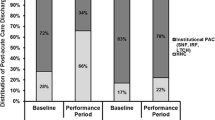Abstract
The Prometheus Payment Model offers a potential solution to the failings of the current fee-for-service system and various forms of capitation. At the core of the Prometheus model are evidence-informed case rates (ECRs), which include a bundle of typical services that are informed by evidence and/or expert opinion as well as empirical data analysis, payment based on the severity of patients, and allowances for potentially avoidable complications (PACs) and other provider-specific variations in payer costs. We outline the methods and findings of the hip and knee arthroplasty ECRs with an emphasis on PACs. Of the 2076 commercially insured patients undergoing hip arthroplasty in our study, PAC costs totaled $7.8 million (14% of total costs; n = 699 index PAC stays). Similarly, PAC costs were $12.7 million (14% of total costs; n = 897 index PAC stays) for 3403 patients undergoing knee arthroplasty. By holding the providers clinically and financially responsible for PACs, and by segmenting and quantifying the type of PACs generated during and after the procedure, the Prometheus model creates an opportunity for providers to focus on the reduction of PACs, including readmissions, making the data actionable and turn the waste related to PAC costs into potential savings.



Similar content being viewed by others
References
Aaron HJ. Waste, we know you are out there. N Engl J Med. 2008;359:1865–1867.
AHRQ. Clinical Classification Software (CCS) for ICD-9 CM. 2008. Available at: http://www.hcup-us.ahrq.gov/toolssoftware/ccs/ccs.jsp. Accessed Feb 21, 2009.
AHRQ. Clinical Classification Software for Services and Procedures. 2008. Available at: http://www.hcup-us.ahrq.gov/toolssoftware/ccs_svcsproc/ccssvcproc.jsp. Accessed Feb 21, 2009.
AHRQ. Quality Indicators: Guide to Patient Safety Indicators. 2007. Available at: http://www.qualityindicators.ahrq.gov/downloads/psi/psi_guide_v31.pdf. Accessed October 30, 2008.
Coleman EA, Parry C, Chalmers S and Min SJ. The care transitions intervention. Arch Intern Med. 2006;166:1822–1828.
De Brantes F. Pay for Performance and Beyond: A Recipe for Improving Healthcare. The Quality Conundrum: Practical Approaches for Enhancing Patient Care. 2008:110–114. Available at: http://www.pwc.com/extweb/pwcpublications.nsf/docid/c0204123b329c1d38525726700760e29. Accessed October 30, 2008.
De Brantes F, Camillus JA. Evidence-informed case rates: a new health care payment model. The Commonwealth Fund Web site. Available at: http://www.cmwf.org/Content/Publications/Fund-Reports/2007/Apr/Evidence-Informed-Case-Rates--A-New-Health-Care-Payment-Model.aspx. Accessed March 30, 2009.
De Brantes F, Rastogi A. Evidence-informed case rates: paying for safer, more reliable care. Issue Brief (Commonwealth Fund). 2008;40:1–13.
De Brantes F, D’Andrea G, Rosenthal M. Should health care come with a warranty? Health Affairs. 2009;28:w678–w687.
Department of Health and Human Services Center for Medicare and Medicaid Services. Proposed Rules. 73:23547–23562. Available at: http://edocket.access.gpo.gov/2008/pdf/08-1135.pdf. Accessed October 29, 2008.
ECRI Institute. Special Advisory: List of CMS Hospital-Acquired Conditions Expanded Under New Final Rule. 2008. Available at: https://www.ecri.org/PatientSafety/HrcReports/Pages/CMS_Final_Rule_on_Hospital_Acquired_Conditions.aspx. Accessed October 30, 2008.
Encinosa WE, Hellinger FJ. The impact of medical errors on ninety-day costs and outcomes: an examination of surgical patients. Health Serv Res. 2008;43:2067–2085.
Fabri PJ, Zayas-Castro JL. Human error, not communication and systems, underlies surgical complications. Surgery. 2008;144:557-563;discussion 563–565.
Fisher ES, Staiger DO, Bynum JPW, Gottlieb DJ. Creating accountable care organizations: the extended hospital medical staff. Health Affairs. 2007;26:w44–w57.
Fuchs VR. Three ‘inconvenient truths’ about health care. N Engl J Med. 2008;359:1749–1751.
Haentjens P, Autier P, Barette M, Boonen S. Costs of care after hospital discharge among women with a femoral neck fracture. Clin Orthop Relat Res. 2003;414:250–258.
Iezzoni LI. Risk Adjustment for Measuring Health Care Outcomes. 3rd Ed. Chicago, IL: Health Administration Press;2003.
Jack BW, Chetty VK, Anthony D, Greenwald JL, Sanchez GM, Johnson AE, Forsythe SR, O’Donnell JK, Paasche-Orlow MK, Manasseh C, Martin S, Culpepper L. A reengineered hospital discharge program to decrease rehospitalization: a randomized trial. Ann Intern Med. 2009;150:178–187.
O’Kane M, Corrigan J, Foote SM, Tunis SR, Isham GJ, Nichols LM, Fisher ES, Ebeler JC, Block JA, Bradley BE, Cassel CK, Ness DL, Tooker J. Crossroads in quality. Health Aff (Millwood). 2008;27:749–758.
Mechanic RE, Altman SH. Payment reform options: episode payment is a good place to start. Health Aff (Millwood). 2009;28:w262–w271.
McGlynn EA, Asch SM, Adams J, Keesey J, Hicks J, DeCristofaro A, Kerr EA. The quality of health care delivered to adults in the United States. N Engl J Med. 2003;348:2635–2645.
MedPAC. Report to the Congress: Promoting Greater Efficiency in Medicare. 2007. Available at: http://www.medpac.gov/documents/jun07_EntireReport.pdf. Accessed October 29, 2008.
Mutti A. Policies to encourage collective accountability: readmissions and bundled payment. Available at: http://www.ehcca.com/presentations/hcii1/mutti_1.pdf. Accessed October 29, 2008.
Neter J, Wasserman W, Kutner MH. Applied Linear Statistical Models. 3rd Ed. Homewood, IL: Irwin;1990.
PricewaterhouseCoopers’ Health Research Institute. The Price of Excess: Identifying Waste in Healthcare Spending. 2008. Available at: http://pwchealth.com/cgi-local/hregister.cgi?link=reg/waste.pdf. Accessed October 30, 2008.
Prometheus Payment Inc. Available at: http://www.prometheuspayment.org/. 2008. Accessed Feb 20, 2009.
Rosenthal MB. Beyond pay for performance—emerging models of provider-payment reform. N Engl J Med. 2008;359:1197–1200.
Wharam JF, Sulmasy D. Improving the quality of health care: who is responsible for what? JAMA. 2009;301:215–217.
Wennberg JE, Bronner K, Skinner JS, Fisher ES, Goodman DC. Inpatient care intensity and patients’ ratings of their hospital experiences. Health Aff (Millwood). 2009;28:103–112.
Wilson NA, Schneller ES, Montgomery K, Bozic KJ. Hip and knee implants: current trends and policy considerations. Health Aff (Millwood). 2008;27:1587–1598.
Acknowledgments
We thank the Robert Wood Johnson Foundation for their grant and their support in making this study possible.
Author information
Authors and Affiliations
Corresponding author
Additional information
Bridges to Excellence is funded by the Robert Wood Johnson Foundation.
About this article
Cite this article
Rastogi, A., Mohr, B.A., Williams, J.O. et al. Prometheus Payment Model: Application to Hip and Knee Replacement Surgery. Clin Orthop Relat Res 467, 2587–2597 (2009). https://doi.org/10.1007/s11999-009-0942-3
Received:
Accepted:
Published:
Issue Date:
DOI: https://doi.org/10.1007/s11999-009-0942-3




